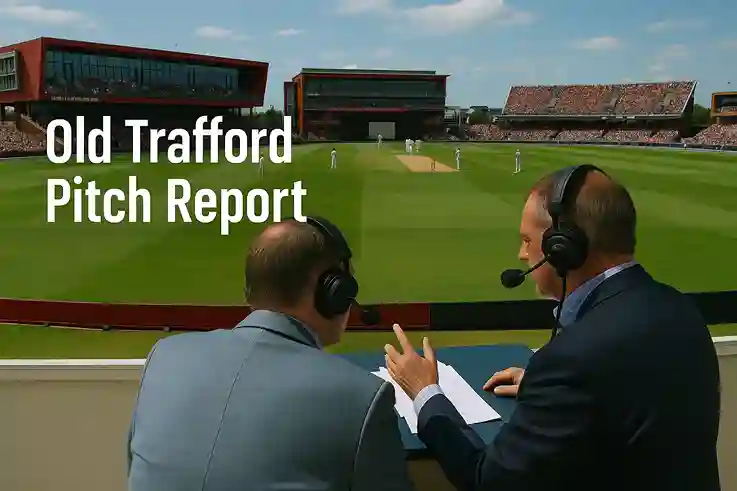Cricket fans and analysts always ask: What’s the pitch like at Old Trafford. This historic ground offers a balanced surface good for batting early on but tougher as the match progresses. Whether it’s Tests ODIs or T20s the pitch behaves differently making it a fascinating challenge for players and a key factor for fans and bettors.
In Test matches the pitch starts with pace and bounce but slows down helping spinners by Day 4-5. T20 games see high scores (avg. 160-180), but big boundaries and smart bowling keep things competitive. Weather also plays a big role cloudy skies help swing bowlers while sun favors batters.
This guide covers pitch conditions records weather impact and winning strategies. You’ll get expert insights on how to read the pitch, key stats, and answers to common questions everything you need to understand Old Trafford’s famous surface.
Key Highlights
✔ Pitch Behavior: Balanced good for batters early, favors bowlers later.
✔ Format Differences: Tests (spin-friendly late), ODIs (chasing advantage), T20s (high-scoring but fair).
✔ Weather Impact: Cloud = swing, sun = better batting, rain = slower pitch.
✔ Records: Highest scores, best bowling spells, and average totals.
✔ Tactics: Bat first in Tests, chase in ODIs, power-hitting in T20s.
Old Trafford Pitch Report: A Complete Guide (2025)
Cricket fans, players and analysts often wonder What makes Old Trafford’s pitch unique. Whether you’re checking conditions for an upcoming match analyzing player performance or placing a bet understanding the pitch is crucial.
This guide covers Old Trafford’s pitch behavior in Tests ODIs and T20s including weather impact records and tactical insights. We’ll also answer the most-searched questions to give you a 360-degree view of this historic ground.
Key Highlights
✔ How the pitch behaves over 5 days (Tests) vs. 20 overs (T20s).
✔ Whether it favors batting or bowling.
✔ Key stats like average scores and best performances.
✔ How weather impacts play.
✔ Strategic tips for captains and fantasy cricket players.
Old Trafford Pitch: General Behavior & Characteristics
Old Trafford’s pitch is known for its balanced nature, offering something for both batters and bowlers. Historically, it starts with good pace and bounce but slows down as the match progresses, making strokeplay tougher.
In Test matches the pitch tends to deteriorate by Day 4-5, aiding spinners. For T20s, it’s generally true and even-paced allowing big hits but also rewarding disciplined bowling. The outfield is quick adding value to well-timed shots.
Key Highlights
-
Grass cover: Moderate (helps seamers early).
-
Bounce: Even but not excessively steep.
-
Turn: Increases as the game progresses.
-
Pace: Slows down in later innings.
-
Durability: Holds up well despite wear.
In short, Old Trafford’s pitch is versatile, adapting to different formats while keeping contests fair.
Match-Specific Pitch Reports
Old Trafford’s pitch behavior varies significantly by format: in Test matches, it offers early seam movement before slowing down favoring spinners by Day 4-5 with an average 1st innings score of 320-350; in ODIs
it’s balanced but slightly better for chasing with teams averaging 270 and in T20s, the pitch is true-paced but not flat yielding an average score of 160-180 where power-hitters thrive but clever bowlers exploit the large boundaries (65-75m) with cutters and slower balls.
Weather also plays a key role overcast skies aid swing, while dry conditions help batters, making adaptability crucial across all formats.
Old Trafford Pitch for Test Matches
Test matches at Old Trafford often see early assistance for fast bowlers due to moisture and grass. As the game progresses, spinners come into play, especially on Days 4-5 when cracks widen.
Batters who adapt to variable bounce thrive here. Notable performances include Sanath Jayasuriya’s 213 and Jimmy Anderson’s match-winning spells. Teams batting first average 350+, but collapses are common if bowlers exploit conditions.
Key Test Match Trends:
-
Day 1-2: Best for batting.
-
Day 3-4: Balanced (pace & spin).
-
Day 5: Spinners dominate.
-
Average 1st innings score: 320-350.
-
Highest Test total: 656/8 (England vs Australia, 1964).
Patience is key early consolidation leads to big scores, while aggressive play risks early wickets.
Old Trafford Pitch for T20s
T20 games at Old Trafford are high-scoring but not a flat track. The pitch holds up well, allowing batters to play shots, but smart bowlers use slower balls and cutters effectively.
The average T20 score is 160-180, with teams chasing successfully 60% of the time. Big boundaries (70m+) mean clearing the ropes requires power, and spinners benefit from grip as the ball gets older.
Key T20 Stats:
-
Avg. 1st innings score: 165.
-
Highest T20 total: 231/4 (Lancashire vs Worcestershire, 2023).
-
Best bowling: 5/11 (Rashid Khan).
-
Win toss & bowl first? Yes (dew minimal).
-
Boundary size: 65-75m.
*Smart bowling changes and power-hitting in the middle overs decide T20 games here.*
Weather Impact on Old Trafford Pitch
Weather plays a huge role at Old Trafford. Overcast conditions help swing bowlers, while dry spells make batting easier. Rain interrupts play frequently, but the drainage system is excellent—matches resume quickly.
In day-night games, dew is less of a factor compared to Indian pitches, but evening sessions may offer extra swing. Cloud cover historically favors seamers, as seen in James Anderson’s dominance here.
Weather-Based Trends:
-
Rain: Slows the pitch, favors spinners.
-
Sunny weather: Better for batting.
-
Cloudy skies: Swing & seam movement.
-
Dew impact: Minimal in T20s.
-
Wind factor: Can assist reverse swing.
Always check the forecast conditions can shift a match’s momentum in a session.
Batting vs Bowling: Who Benefits More?
Old Trafford is neither a batter’s paradise nor a bowler’s graveyard. It rewards technique and adaptabilitybatters who leave well and bowlers who exploit subtle variations thrive.
In Tests, fast bowlers dominate early, while spinners control later stages. In T20s, power-hitters succeed, but bowlers with variations (slower balls, cutters) keep runs in check.
Who Has the Edge?
-
Test matches: Bowlers (Day 1 & Day 5).
-
ODIs: Balanced (chasing preferred).
-
T20s: Slight advantage to batters.
-
Spinners vs Pacers: Depends on wear.
-
Toss decision: Bowl first in Tests, bat first in T20s.
Adaptability wins matches neither pure aggression nor extreme caution works alone.
🏴 The Heartbeat of English Cricket: From Iconic Grounds to the National Team
The roar of the crowd at Edgbaston, the swing-friendly conditions at Trent Bridge, and the rich history of the England team itself these are the elements that define the sport in England.
Each ground offers a unique challenge, shaping the strategies and unforgettable moments we cherish. Understanding these venues and the squad that represents the nation provides a deeper connection to every match. Explore the resources below to delve into the details that make English cricket truly special.
| Feature | Description & Link |
|---|---|
| Edgbaston Cricket Ground | Known for its electric atmosphere and a pitch that often produces exciting, balanced contests. Read the Edgbaston Pitch Report |
| Headingley | A classic English ground famous for its seamer-friendly conditions and dramatic Test match history. Read the Headingley Pitch Report |
| Trent Bridge | A legendary venue where the ball has a history of swinging prodigiously, testing the best batsmen. Read the Trent Bridge Pitch Report |
| Riverside Ground | The picturesque home of Durham County Cricket Club, offering a modern cricketing experience. Read the Riverside Ground Pitch Report |
| The Oval Capacity | Discover the seating capacity and the immense scale of London’s famous international cricket ground. Check The Oval’s Capacity |
| England Cricket Team | Explore the history, players, and legacy of the national team that carries the hopes of a nation. Learn About the England Team |
Old Trafford Pitch Records & Stats
Old Trafford has witnessed some of cricket’s most memorable performances across formats. In Tests, the highest team total is England’s mammoth 656/8 against Australia in 1964, while Jim Laker’s iconic 8/34 in 1956 remains the best bowling figures.
The average first-innings score hovers around 320, with pitches typically deteriorating by Day 4-5 to assist spinners.
In ODIs, England’s 397/6 against Netherlands (2022) stands as the highest total, with Mitchell Starc’s 6/14 (2018) being the best bowling performance.
The average ODI score is 270, with chasing teams winning 60% of matches thanks to the pitch’s even bounce.
For T20s Lancashire’s 231/4 (2023) is the highest score, while Rashid Khan’s 5/11 (2019) tops the bowling charts. The average T20 total is 165, with spinners and pacers who mix their lengths effectively finding success.
| Format | Highest Team Total | Best Bowling Figures | Average Score | Win Toss &? |
|---|---|---|---|---|
| Test | 656/8 (ENG vs AUS, 1964) | 8/34 (Jim Laker, 1956) | 320 | Bat first |
| ODI | 397/6 (ENG vs NED, 2022) | 6/14 (Mitchell Starc, 2018) | 270 | Chase |
| T20 | 231/4 (Lancashire, 2023) | 5/11 (Rashid Khan, 2019) | 165 | Bowl first |
Notable Individual Records
-
Highest Test score: 273 (Sir Leonard Hutton, ENG vs WI, 1950)
-
Best Test match figures: 19/90 (Jim Laker, ENG vs AUS, 1956)
-
Fastest T20 century: 42 balls (Liam Livingstone, LANCS vs BIRM, 2022)
-
Most wickets at ground: James Anderson (Test), 60+ scalps
Old Trafford’s stats reveal a pitch that rewards skill in all formats whether it’s a batter’s patience in Tests or a bowler’s variations in T20s.
Old Trafford Pitch Records (All Formats)
| Format | Highest Team Total | Best Bowling | Avg. Score |
|---|---|---|---|
| Test | 656/8 (ENG) | 8/34 (Laker) | 320 |
| ODI | 397/6 (ENG) | 6/14 (Starc) | 270 |
| T20 | 231/4 (LANCS) | 5/11 (Khan) | 165 |
Old Trafford Pitch Conditions by Format
| Format | Early Behavior | Late Behavior | Best Strategy |
|---|---|---|---|
| Test | Pace-friendly | Spin-friendly | Bat first, bowl late |
| ODI | Even-paced | Slows slightly | Chase preferred |
| T20 | True bounce | Cutters work | Powerplay aggression |
FAQs
Q1. Is Old Trafford a batting or bowling pitch?
It’s balanced—pace early, spin late in Tests; batting-friendly but fair in T20s.
Q2. Does Old Trafford favor spinners or pacers?
Pacers early, spinners later (especially in Tests).
Q3. What’s the average T20 score at Old Trafford?
160-180—big boundaries keep scores in check.
Q4. How does rain affect the pitch?
Makes it slower, aiding spinners and reducing bounce.
Q5. Should you bat or bowl first in Tests?
Bat first—pitch deteriorates later.
Conclusion
Understanding Old Trafford’s pitch is the key to unlocking better cricket decisions whether you’re a player fan or bettor. From Tests to T20s this ground rewards adaptability, with conditions shifting from session to session. Batters must capitalize early while bowlers need patience to exploit the pitch’s late tricks. Weather toss choices and even boundary sizes play crucial roles in shaping the game.
If you’re visiting the stadium, use this knowledge to your advantage:
✔ Check the weather—cloudy skies? Expect swing. Sunny? Batting gets easier.
✔ Watch the pitch wear—cracks and rough patches mean spinners will dominate later.
✔ Study past records—know which players thrive here and why.
Armed with these insights you’ll see Old Trafford’s matches in a whole new light. Next time you’re at the ground, you won’t just watch cricket you’ll read it like a pro!

